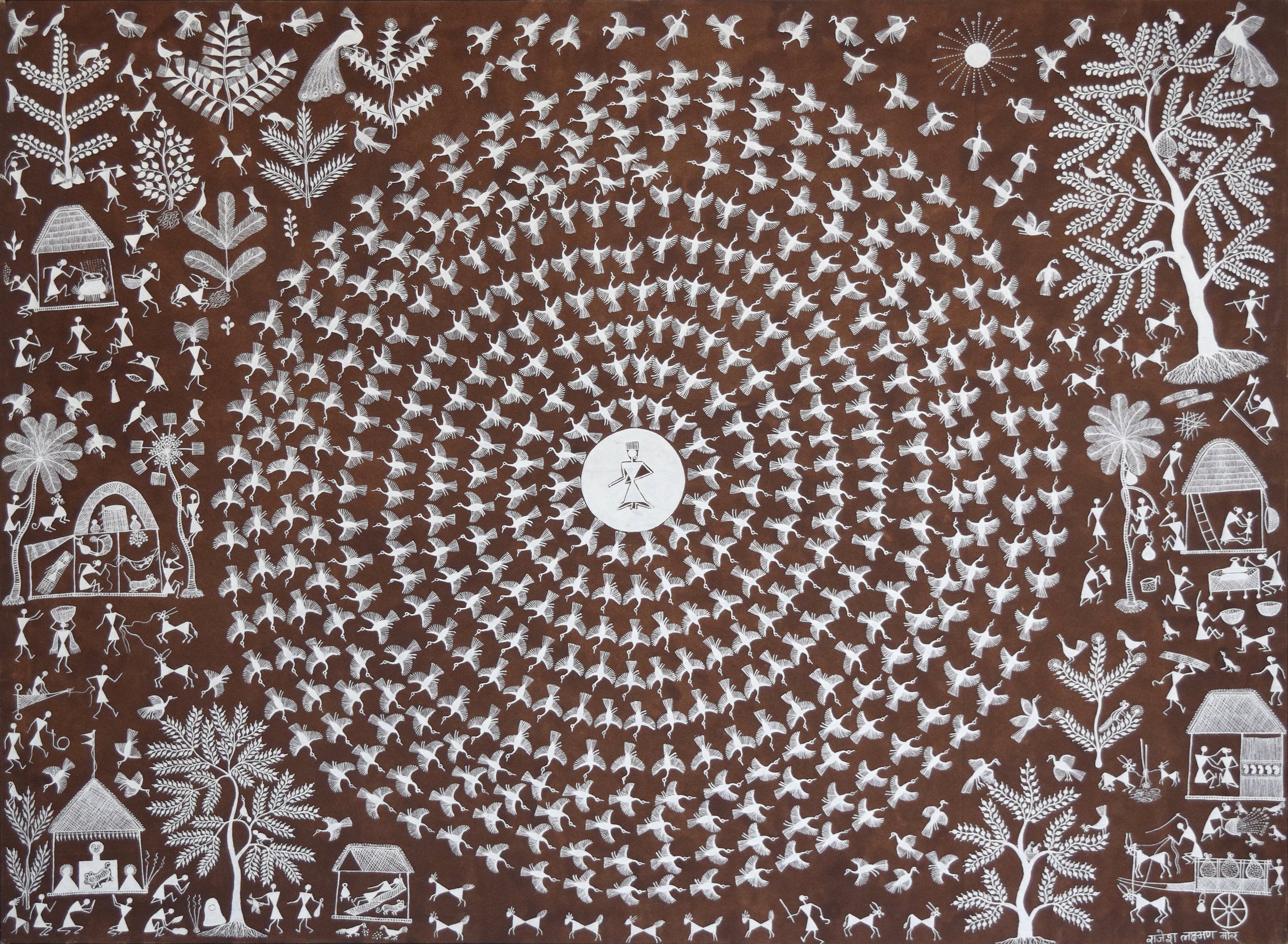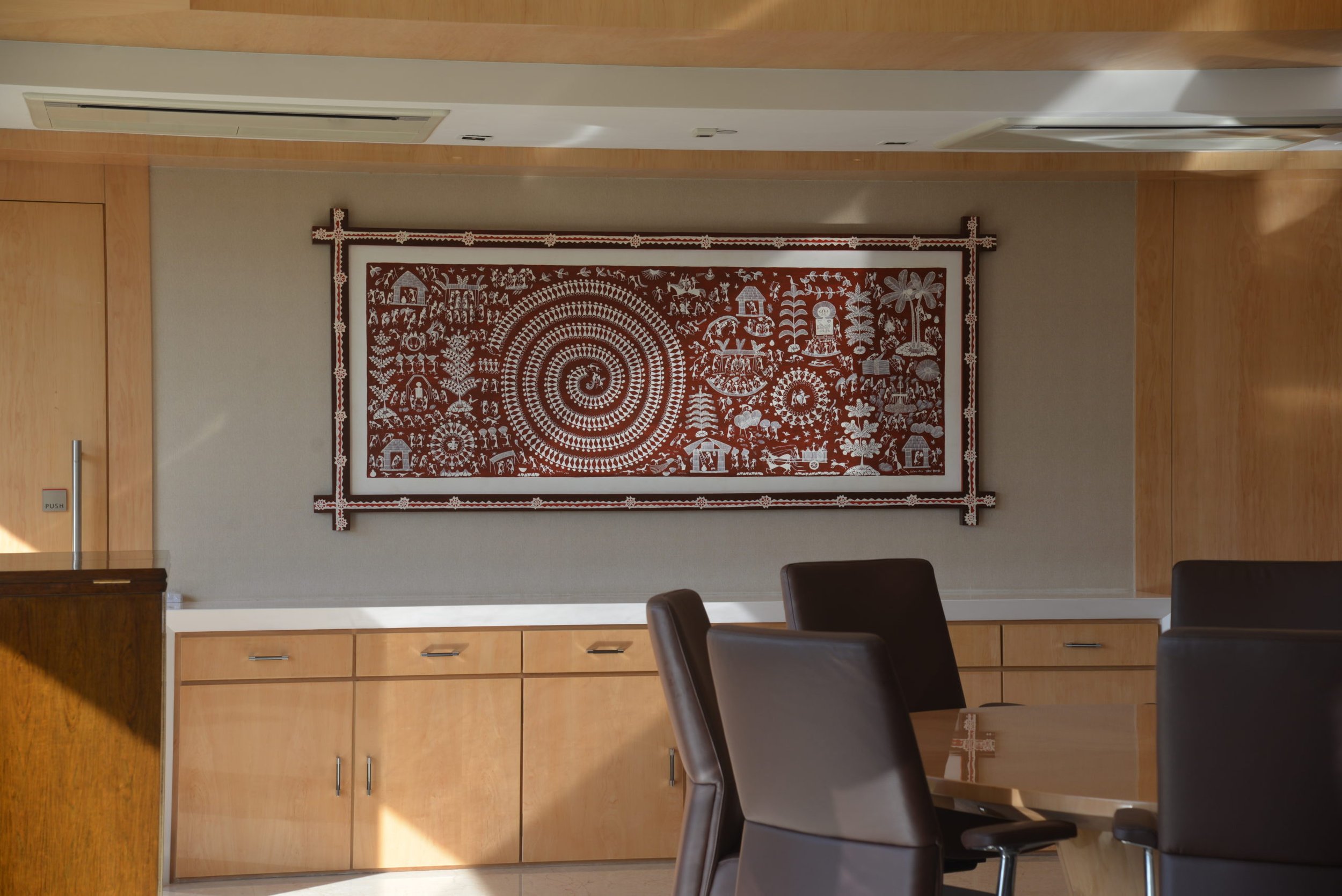The tale of an ever-evolving art form!
Warli tribal art and its placement in the changing cultural syntax.
Tribal Worship, Artist: Rajesh Mor, Style: Warli, Medium: Acrylic and cow dung on cloth, Size: 48x36 in
The walls are replaced by well-structured canvasses and the natural dyes with artificially produced colours, but what Warli tribal art has not lost, over all these years of practice, is the ability to narrate stories through simplistic motifs. Practised by the Warli tribe, which comes from the mountainous and coastal regions along the Maharashtra-Gujarat border, this art form is one of the oldest surviving tribal art forms.
Despite such an extensive and elongated history that is bound to bring some variations in practice, this primitive art form still carries within itself the essence that makes it what it is, that fundamental core that these paintings have harboured for all these years with well-adapted modern adjustments. These adjustments do not adulterate the form but only highlights the ability of the art form to evolve with changing times and absorb themes due to contemporary lifestyle shifts but without ever losing ground.
Evolving themes
The quintessence of Warli is in its teachings about life, it helps one seek out happiness, beauty, pleasure and fulfilment in everyday existence. We are beings of nature, the environment brings us into life, enables our growth and on our death beds, we finally become one with nature again. This art teaches us that life isn’t a combination of extraordinary moments; it is a combination of ordinary moments lived extraordinarily. These themes still make strong appearances in the art of contemporary practitioners and the goal still is to teach the biggest lessons in the easiest possible manner.
Farming was the main economic activity of the Warli tribe back in the day and is still the primary source of income but contemporary troubles caused due to climate change like floods and famines also find representation in the paintings nowadays. Since the economy is not entirely agricultural-based, there is also a shift to a more personal negotiation of the artist with nature.
Warli for modern art enthusiasts
Modern Warli Art has replaced the traditional dots and dashes with a continuous line, this fits well with the need to produce art as a mode of quick consumption for the modern onlookers who often do not have the time and understanding to bask in the glory of a deeply detailed piece. There has also been a lot of experimentation with various colour palettes apart from traditional white on red/brown.
Image courtesy: Roomfruit
This helps the art find its place in modern households as could be more adaptable to a variety of architectural colour themes. Warli Art is not restricted to art pieces to adorn the walls but the markets are flooded with consumer goods painted with this art form like garments, furniture, stationary, etc.
Image courtesy: Baaya Design
Image courtesy: Pinterest
Warli Art’s future and our work @CCDF
Mr Sundeep Bhandari, CCDF founder believes ‘The World must get to glimpse the beauty of our folk art traditions as well.” And so we at Craft and Community Development Foundation (CCDF), encourage traditional artists to look at ways in which their art can be made more viable for the modern art enthusiasts, they are given an understanding of modern techniques and themes and through this little assistance that we provide, the artwork that emerges is worth marvelling.
Let us immerse ourselves in the worlds of these artists and their artistry.
Image Courtesy: Craft & Community Development Foundation
Flood and Famine, Artist: Anita Balu Mhase, Style: Warli, Medium: Acrylic and cow dung on cloth, Size: 48x36 in
The painting above represents the harshness of nature, by depicting floods that often rot the crops creating a situation of famine in tribal regions of Maharashtra as these communities are heavily dependent on nature for their cropping patterns.
Image Courtesy: Craft & Community Development Foundation
Fox and Crocodile, Artist: Anita Balu Mhase, Style: Warli, Medium: Acrylic and cow dung on cloth, Size: 48x36 in
The greedy crocodile tried to trap and kill the fox. The sly fox gets away but gets bitten off by a scorpion and dies due to it. Everything in nature is in connection with another, nothing exists in a vacuum and so the painting above depicts this profound truth by highlighting the uncertainties in life; today’s triumph is tomorrow’s downfall and vice-a-versa.
References:
https://yehaindia.com/warli-art-a-trivialized-traditional-art/
https://baayadesign.com/the-art-of-warli-painting/
http://www.warli.in/2010/12/evolution-of-warli-art.html
https://www.artystagallery.com/blogs/home-decor/warli-art-the-life-of-tribe
https://www.homesciencejournal.com/archives/2017/vol3issue3/PartF/3-3-70-220.pdf
This article is authored for Craft and Community Development Foundation by Shreya Seth.






